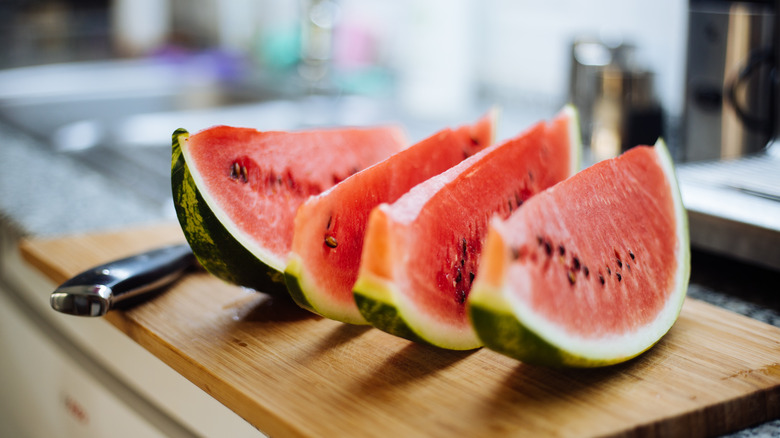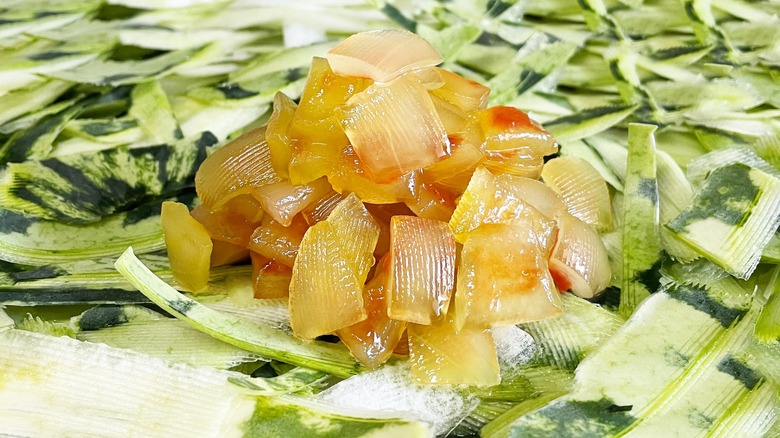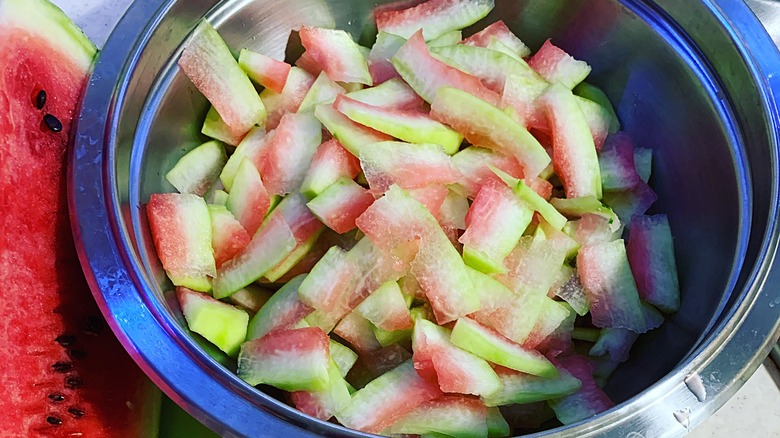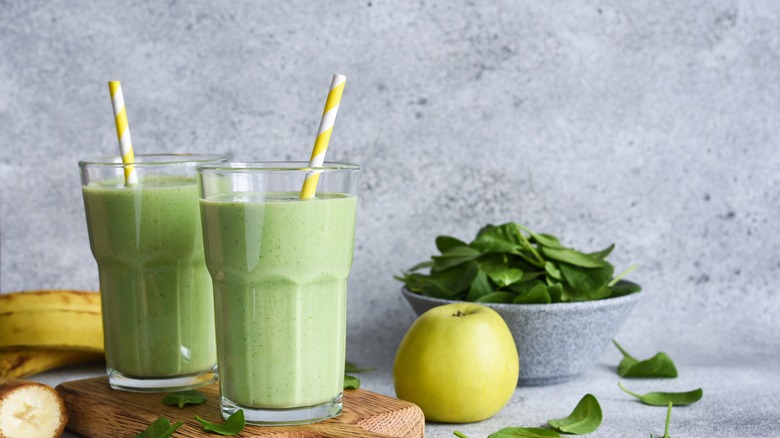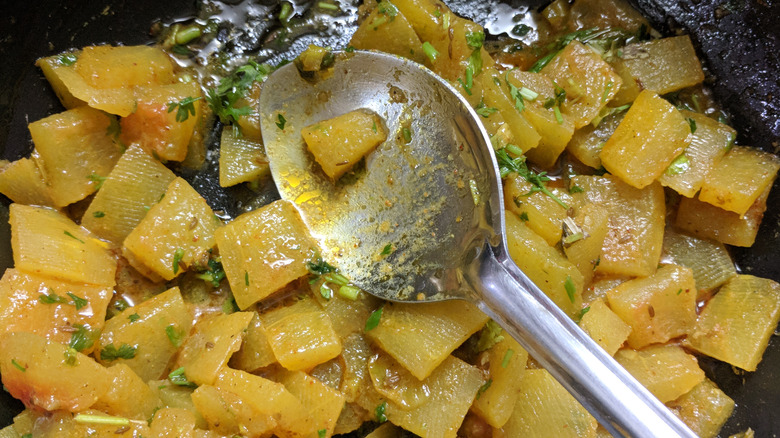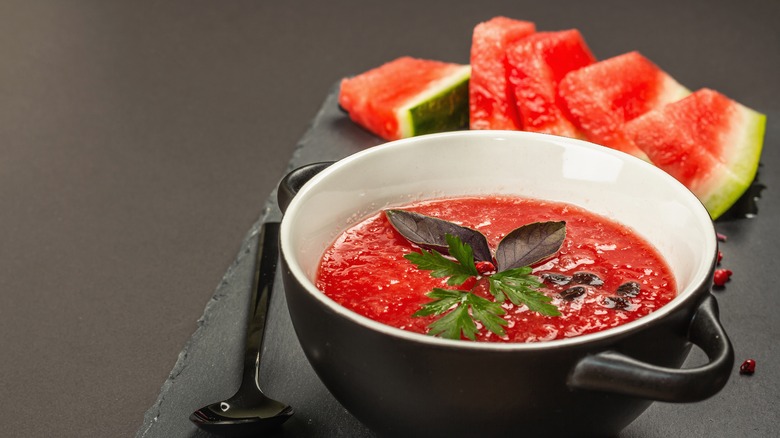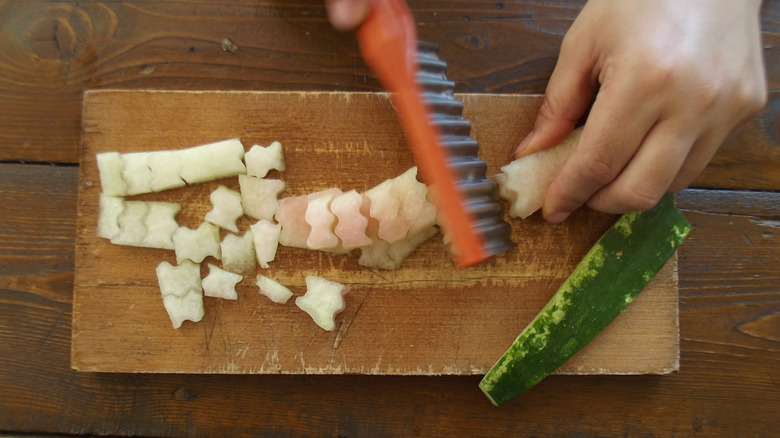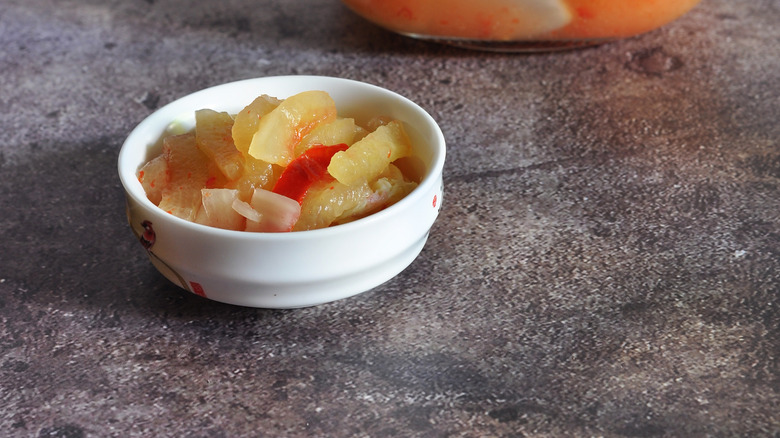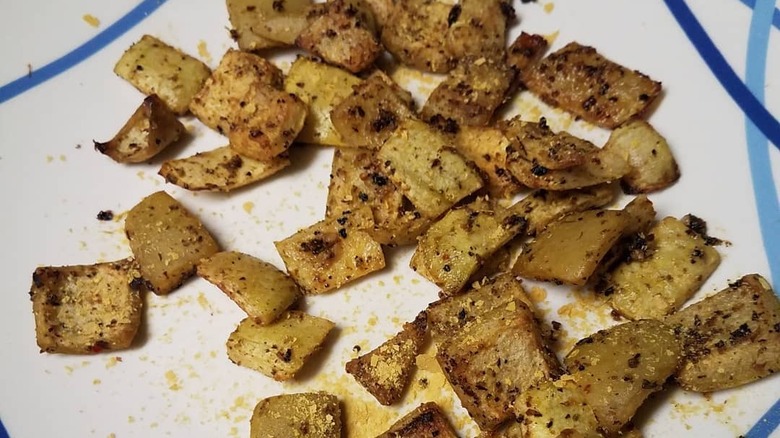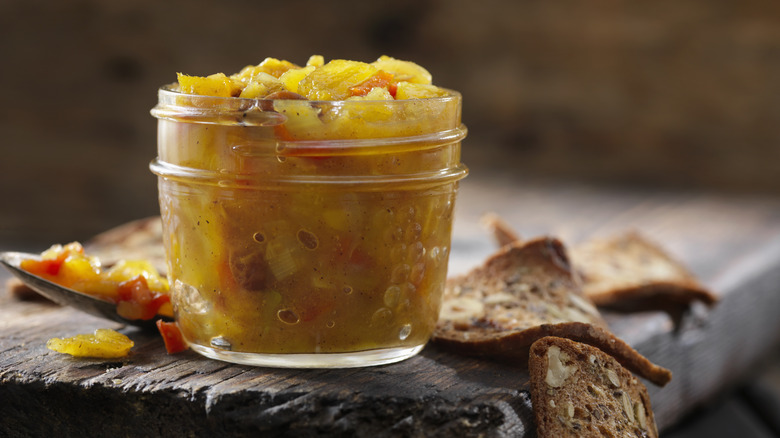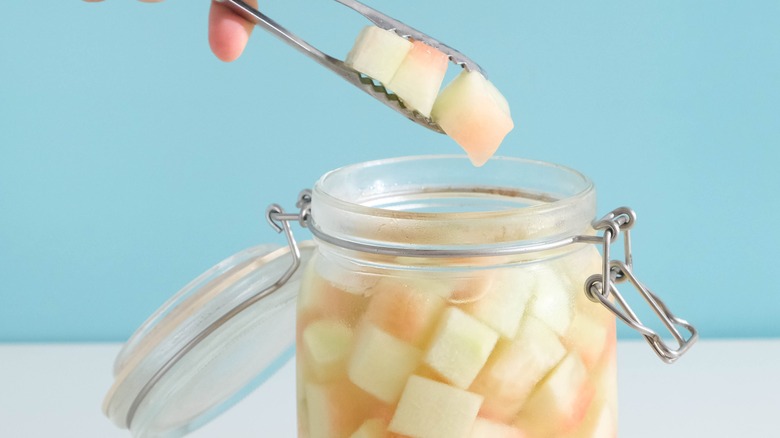12 Tasty Ways To Eat Your Watermelon Rinds
Even if watermelon is a summer staple in your kitchen, you may not be taking full advantage of everything it has to offer — unless you eat the rind. Yes, the rind is perfectly edible. And it's nutritious, with more fiber than watermelon flesh, as well as higher concentrations of citrulline, an amino acid that improves blood flow and is thought to boost some types of athletic performance. And while it's no substitute for Viagra, its high concentration of citrulline can also improve libido in men (via Healthline).
Eating watermelon rind is not a form of self-sacrifice either — it's tasty! And its crisp, cucumber-like texture lends itself to a number of preparations, both sweet and savory. It shows up in old traditional recipes and newly innovated dishes created by sustainability-minded cooks. So if you want to cut back on food waste while keeping bulky piles of rinds out of your trash, here's some flavorful inspiration to get you started.
Sweet watermelon pickles are an old-fashioned classic
If you've heard of eating watermelon rinds at all, there's a good chance it's through old-school watermelon pickles. A traditional favorite in the American South, these sweet pickles shot through with warm spices are made with peeled cubes of watermelon rind and like other relishes, are served as appetizers or at meals as an accompaniment to meats and cheeses.
Watermelon rind pickles aren't difficult to make, but you do need to budget in some time. The crunchy rinds first need to be stripped of their dark green skin, cut into cubes, then tenderized through a combination of overnight brining and simmering. Next, the now-translucent cubes are further cooked in a flavorful mixture of vinegar, sugar, and spices such as cloves and cinnamon before being spooned into sterilized canning jars and sealed in a hot water bath. The sealed jars keep for a year, allowing you to enjoy a memory of summer's watermelon all year long.
Candied watermelon rinds make an unexpected treat
Historically, when cooks wanted to preserve summer fruit for the cold-weather months, one of the techniques they turned to was candying. Not only did it make fruit last longer, it improved its flavor enormously, turning naturally bitter ingredients such as citrus peels into the best versions of themselves. For these reasons, candying is also a great treatment for watermelon rind. While mildly flavored and not nearly as bitter as citrus peel – it has a flavor reminiscent of cucumber – watermelon rind also acquires deeper, more interesting flavors when candied, evolving into a treat that actually tastes a bit like watermelon.
Candying watermelon rind involves the same techniques as candying citrus peel. Like citrus peel, watermelon rind needs to be boiled and rinsed several times to become tender enough to enjoy as candy. Next, the tenderized rind is slowly cooked in sugar syrup until the pieces become clear. After being removed from the syrup and allowed to drain on a rack, the candied rind pieces can be tossed in granulated sugar if desired to form a snowy, slightly crunchy coating.
Change up your toast toppings with watermelon rind jam
If you're looking for a changeup from strawberry and raspberry jam for your breakfast spread, consider making watermelon rind jam. While it's tough to picture something as hard and thick as watermelon rind melting down into a spreadable form, it does indeed cook into a sweet, sandwich-friendly condiment. While the finely chopped rind in the jam doesn't fully dissolve the way most berries do, it does soften and transform into appealing candied bits, much like the fragments of rind in marmalade. Because watermelon rind jam is mildly flavored — its flavor has been compared to that of a honeydew melon — it lends itself to the addition of other flavors, such as lime or vanilla.
To make watermelon rind jam, remove the green outer layer and finely chop the peeled rind. Mix the chopped rind with sugar (and citrus/spices, if using) and allow to rest overnight, and covered. The next day, gently cook the rind and sugar until the rind is translucent — and then store in sterilized jars. What's next? Entertain and amaze your guests by asking them to guess what's in those jars.
Julienned watermelon rind is great in stir fries
One of the fun things about cooking with watermelon rind is its versatility. Depending on how you cook it, it can be either sweet or savory, soft or crunchy. And an easy way to showcase its naturally dense, crunchy texture is to julienne it and cook it in stir-fries. Because of the rind's naturally mild flavor, it acts more like a vegetable than a fruit in this context.
A stir-fry is also one of the quickest ways to make use of watermelon rind. The only preparation the rind needs before cooking is peeling (the dark green skin isn't great to eat) and slicing. And while hard and crisp when raw, it only takes minutes of stir-frying for it to become tender and absorb the flavors from the sauce and other seasonings. Since watermelon rind doesn't have an assertive flavor on its own, it readily fits in with a range of stir-fry treatments, from savory to sweet and sour and beyond. So feel free to use watermelon rind as a sub for other veggies in your next stir-fry, no matter how you season it.
Blitz and freeze rinds to make nutritious smoothie cubes
Health-minded eaters seeking to get the most from their fruits and veggies know that concentrating them in a smoothie is a great way to get lots of nutrients quickly and enjoyably. If you're a smoothie fan, consider watermelon rind a useful addition to your recipes, since it's a powerful source of nutrients. While low in calories, watermelon rind is packed with fiber, along with potassium, zinc, lycopene, and vitamins A, C, and B6, which contribute to healthy skin and blood pressure and strengthen the immune system.
But of course, removing the rind from a watermelon, cutting it up, and figuring out what to do with the rest of the melon may not be convenient on busy weekday mornings. With a little advanced planning, however, you can enjoy the benefits of watermelon rinds without a lot of time or extra cleanup by making smoothie cubes. Cut up the rind (in this case, a bit of the pink flesh on the inside is fine), puree it in a blender, and freeze the puree in ice cube trays. When it's time to make your next smoothie, just pop out one or more of the cubes and toss it in the blender with your other fruits and veggies.
Watermelon rinds are the star ingredient in a traditional Indian curry
The idea of eating watermelon rind isn't a new concept. Nor is it the unique purview of Depression-era American grandmas making pickles with anything and everything from their gardens. Cooks in India, especially in the state of Gujarati, have long known that watermelon rind can be cooked up and served as a vegetable dish or main course. For instance, in the traditional dish kalingar nu shaak, or watermelon rind curry, the rind is treated much like a hard squash — it's peeled, cut into chunks, and gently simmered with dried spices and other flavorings until tender and saucy.
While watermelon rind itself is rather mild and bland, watermelon rind curry is anything but that.. Recipes vary, but a basic formula involves quickly sizzling dried spices such as cumin, fenugreek, asafetida, and curry leaves in oil along with onions, garlic, and minced ginger, lightly sautéing the hunks of rind in the spiced oil, then simmering (or pressure-cooking) the rind until it's fork tender. The cooked rind is finished with a splash of oil, fried with additional flavorings such as fresh and dried chiles, then topped with cilantro leaves and a squeeze of lemon. Some recipes include additional ingredients, such as mustard oil and amchoor (powdered dried green mango), for extra punch and spiciness.
Use the whole watermelon to make gazpacho
Gazpacho — a chilled soup of pureed or finely chopped raw vegetables — is a summer classic because it's refreshing for both cooks and eaters. Cooks love it because it requires no cooking, meaning they can keep themselves and their kitchens cool on hot days. And diners love the vibrant, tangy refreshment it offers. Gazpacho is commonly made with summer vegetables such as tomatoes, peppers, and cucumbers, but to include a hint of sweetness to the classic dish, add watermelon (rind and all) to a classic tomato gazpacho recipe.
This isn't as strange as it sounds. The color and juiciness of red watermelon complements that of tomatoes, and because watermelon rind has a similar color and flavor as cucumber (watermelon and cucumber are actually related), it fits in nicely as a novel substitute for the more-familiar vegetable. While the watermelon and its rind replace most of the tomatoes and all of the cucumber, the other ingredients — vinegar, onions, garlic, basil, salt, pepper, and olive oil — are the same as those in a standard gazpacho. And it's quick to make — just roughly chop any ingredients that need chopping, whir in a blender until smooth, chill, and enjoy.
Steam and season watermelon rind to make a refreshing salad
You've probably had watermelon chunks in fruit salads and welcomed the sweetness and juiciness they contributed. Or perhaps you've enjoyed watermelon as the centerpiece of sweet/savory salads such as watermelon panzanella. But the rind of watermelon, while less showy and sweet than the flesh, also makes a great base for a salad — and if you already have a watermelon on hand, overlooking the rind is a missed opportunity. Think about it: Watermelon is sold by weight, but typically, only 47% of the whole melon is considered usable food. But if you're among the cognoscenti who understand the potential offered by the rind, you can make use of almost all the melon.
You can make a flavorful watermelon rind salad in roughly the same way you'd make a cooked carrot salad. First, peel the rind and cut it into bite-size chunks. Next, steam it until tender and allow to cool before tossing it in dressing. A flavorful option to try is a Moroccan-inspired combination of cumin, paprika, lemon, ginger, cilantro, scallions, and garlic, along with oil and a touch of cayenne for extra heat. Allow the rind to marinate in the dressing for at least half an hour so the flavors can fully permeate the rind.
Add spice to your meals with watermelon rind kimchi
Contrary to popular belief, the Korean term "kimchi" doesn't refer just to spicy pickled cabbage. Instead, it encompasses a whole family of pickled, fermented vegetables enjoyed in Korean cuisine. While red-chili-laced, garlic-heavy cabbage kimchi is the most common variety, numerous other varieties exist as well, including kimchi made with cubes of white radish, and white kimchi, a chile-free version that sometimes includes fruit. Building on the variety is the fact that recipes vary by region and by family, with cooks adding and subtracting ingredients as their tastes or circumstances permit.
In short, imaginative cooks can turn any produce — including watermelon rind — into kimchi. To make watermelon rind kimchi, toss cubes of peeled rind with salt and allow to sit. Rinse off the salt, then toss the cubes with pureed watermelon flesh, chopped scallions, shredded carrots, dried Korean red pepper (gochugaru), minced garlic and ginger, and sugar. Spoon the rind and seasonings into a large glass jar and store in the refrigerator. It's tasty eaten fresh, but acquires its characteristic fermented notes after a few days.
Roast rinds with parmesan for a savory side dish
Because of its neutral flavor, watermelon rind can be treated as both a fruit and as a vegetable. But since it's hard not to associate watermelon rind with the sweet fruit it comes with, it can be challenging to wrap our minds around its potential in savory dishes — especially since most of us aren't used to eating it in the first place.
A simple, but unusual dish that will help you shift your mindset is roasted watermelon rind with parmesan. In this dish, squares of peeled watermelon rind are tossed in olive oil, salt and pepper, and roasted until browned and tender. The chunks are then tossed with shredded parmesan, chopped herbs, and a splash of vinegar. It makes an ideal veggie side dish — interesting and flavorful in its own right, but easy to make while taking care of the rest of the meal. The flavorful bites can also be served as a hot appetizer if you prefer.
Make a sweet and savory chutney
While most of us are familiar with chutney – a tangy, often spicy condiment usually made with fruits, vegetables, vinegar, sugar, and spices – it's not something we typically eat every day. But it's more versatile and useful than you might think. Besides its traditional role as a garnish for curries, it makes a great addition to sandwich fillings and turns into a flavorful quick appetizer when poured atop a block of cream cheese and served with crackers.
While bottled mango chutney is the type most familiar to American cooks and eaters, chutneys can be made with a wide variety of ingredients, from fresh herbs such as cilantro to peanuts and tamarind. Watermelon rind also lends itself to being made into chutney, and it's not hard to make. Just peel and cube the rind and put it in a slow cooker with apple cider vinegar, coconut sugar, garlic, green chile, salt and pepper. Cook on high for five hours. The rind will become tender and pick up the sweet/tangy flavors of the other ingredients and become a flavorful condiment for burgers, sandwiches, or other dishes.
Fermented rinds make a tangy, savory condiment
There's more than one way to pickle a watermelon rind. While the best-known type of watermelon pickle is a sweet-spicy preserve that gets its tang (and staying power) from vinegar and sugar, an alternate strategy is to ferment the rinds in brine and spices until they're pleasantly tart — no vinegar or sugar needed. This is also the traditional technique by which kosher dill pickles were originally made: The old terms "full-sour" and "half-sour" refer to the length of time the pickles are allowed to ferment, with the longer-fermented pickles being the full-sours.
So if you're curious to try watermelon pickles but prefer salty, sour pickles to sweet ones, this is the version to try. To make fermented watermelon rind pickles, make a brine by boiling 2 cups water and adding 1 or 2 tablespoons salt. Cool it to room temperature. While you're waiting for the brine to cool, put cubes of peeled watermelon rind, garlic, mustard seeds, and fresh dill into a clean glass jar. Pour over the cooled brine and store the closed jar in a dark place for three days. If it's not tart enough for your taste, allow it to ferment a few more days. After five days, store it in the refrigerator.

